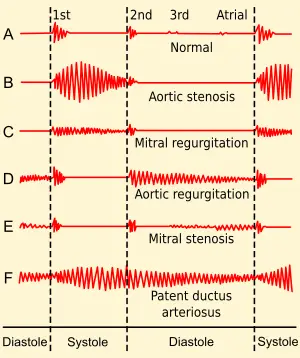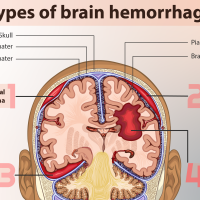Hi there, my friends! In this lesson, we explore aortic stenosis and aortic regurgitation as two common heart conditions that affect the aortic valve, which controls blood flow from the left ventricle to the rest of the body. While both conditions involve the aortic valve, they differ in their underlying causes, symptoms, diagnosis, treatment, and prognosis.

Aortic Stenosis vs Aortic Regurgitation: Symptoms
Aortic stenosis and aortic regurgitation are two common heart conditions that affect the aortic valve. Although both conditions affect the same valve, they have different underlying causes and present with distinct symptoms.
Aortic stenosis occurs when the aortic valve becomes narrowed, restricting blood flow from the left ventricle to the rest of the body. The most common cause of aortic stenosis is the buildup of calcium deposits on the valve, which can occur as a result of aging, genetics, or other medical conditions. As a result, the heart has to work harder to pump blood through the narrow valve, leading to symptoms such as chest pain, shortness of breath, fatigue, dizziness, and fainting. These symptoms can become more pronounced during physical activity or exertion.
In contrast, aortic regurgitation occurs when the aortic valve does not close properly, allowing blood to flow back into the left ventricle instead of out to the rest of the body. Aortic regurgitation is commonly caused by a genetic condition or a disease that weakens the aortic valve, such as rheumatic fever or infective endocarditis. As a result, the heart has to work harder to compensate for the backflow of blood, leading to symptoms such as fatigue, shortness of breath, chest pain, and palpitations. These symptoms can worsen over time as the condition progresses.
Aortic Stenosis = Aortic valve becomes narrowed; often due to buildup of calcium deposits on the valve
Aortic Regurgitation = Aortic valve does not close properly; blood flows back into left ventricle
The symptoms of aortic stenosis and aortic regurgitation can be similar in some ways, but there are some key differences between the two conditions. For example, chest pain is a more common symptom of aortic stenosis than aortic regurgitation. In contrast, palpitations and a pounding or racing heartbeat are more common in aortic regurgitation. Shortness of breath can occur in both conditions, but it may be more severe in aortic stenosis due to the reduced blood flow.
Aortic Stenosis vs Aortic Regurgitation: Diagnosis

Diagnosing aortic stenosis and aortic regurgitation involves a combination of medical history, physical examination, and various imaging and diagnostic tests. While there are similarities in the diagnostic process for both conditions, there are also some key differences.
Medical history and physical examination are typically the first steps in diagnosing aortic stenosis and aortic regurgitation. Patients will be asked about their symptoms, family history, and any other medical conditions they may have. The doctor will also perform a physical examination, paying close attention to the heart sounds and any abnormal rhythms or murmurs.
One of the main diagnostic tools for aortic stenosis and aortic regurgitation is echocardiography, which uses ultrasound waves to create images of the heart and its structures. This test can provide detailed information about the aortic valve, including its size, shape, and function. Echocardiography can also be used to assess the degree of stenosis or regurgitation, as well as any associated changes in the heart muscle or other structures.
Diagnosis Tool #1: Echocardiography – a type of ultrasound to visualize the heart and its structures
Aortic Stenosis on ECHO

Other imaging tests that may be used to diagnose aortic stenosis and aortic regurgitation include cardiac CT scans and cardiac MRI scans. These tests can provide detailed images of the heart and its blood vessels, allowing doctors to assess the severity and extent of the condition.
Diagnosis Tool #2: Cardiac CT Scan and Cardiac MRI Scan – provide more detailed images of the heart and its blood vessels than the echocardiograph
In some cases, a cardiac catheterization may be performed to help diagnose aortic stenosis or aortic regurgitation. During this procedure, a thin tube is inserted into the heart through a blood vessel in the arm or leg, allowing doctors to directly measure the pressure inside the heart and assess the blood flow through the aortic valve.
Diagnosis Tool #3: Cardiac Catheterization – a procedure to directly measure the pressure and blood flow within the heart
There are some differences in the diagnostic process for aortic stenosis and aortic regurgitation. For example, in aortic stenosis, a characteristic heart murmur may be heard during physical examination, whereas this may not always be present in aortic regurgitation. Additionally, echocardiography is typically the first-line imaging test for both conditions, but the specific parameters assessed may differ.
In conclusion, diagnosing aortic stenosis and aortic regurgitation requires a thorough medical history, physical examination, and a combination of imaging and diagnostic tests. While there are some similarities in the diagnostic process for both conditions, there are also some key differences. Early and accurate diagnosis is important for the effective management of these conditions and to prevent serious complications.
Aortic Regurgitation on ECHO

Aortic Stenosis vs Aortic Regurgitation: Treatment
The treatment of aortic stenosis and aortic regurgitation varies depending on the severity of the condition, the patient’s overall health, and other factors. In some cases, medication and lifestyle changes may be sufficient, while in other cases, surgery may be necessary.
Medication can be used to manage symptoms associated with aortic stenosis and aortic regurgitation. For example, medications may be prescribed to reduce blood pressure, improve heart function, or prevent blood clots. However, medication alone is not typically sufficient to treat these conditions.
Surgery for Aortic Stenosis vs Aortic Regurgitation
Surgery is often required to treat aortic stenosis and aortic regurgitation. For aortic stenosis, surgical options may include aortic valve replacement (AVR), which involves replacing the diseased valve with a prosthetic valve. Another option is transcatheter aortic valve replacement (TAVR), which is a minimally invasive procedure that involves replacing the valve using a catheter inserted through a small incision in the leg or chest.
For aortic regurgitation, surgical options may include valve repair or valve replacement. In some cases, aortic root replacement may also be necessary.
There are some differences in the treatment approaches for aortic stenosis and aortic regurgitation. For example, TAVR is a newer procedure that is more commonly used to treat aortic stenosis than aortic regurgitation. Additionally, valve repair may be a more viable option for aortic regurgitation than for aortic stenosis.
It is worth noting that early intervention is crucial in the treatment of both aortic stenosis and aortic regurgitation. Delaying treatment can lead to serious complications, such as heart failure, arrhythmias, or sudden cardiac death.
In conclusion, the treatment of aortic stenosis and aortic regurgitation often involves a combination of medication and surgery. While there are some differences in the treatment approaches for these conditions, early intervention is crucial for the effective management and prevention of serious complications. Patients should work closely with their healthcare providers to develop a personalized treatment plan that is appropriate for their individual needs and circumstances.
Aortic Stenosis vs Aortic Regurgitation: Prognosis

The prognosis for aortic stenosis and aortic regurgitation depends on several factors, including the severity of the condition, the patient’s age, and the presence of other medical conditions. In general, both conditions can have serious long-term consequences if left untreated, but the prognosis can be significantly improved with proper treatment and management.
Aortic Stenosis generally has a poorer prognosis than Aortic Regurgitation (But remember! Everything depends on the severity of the individual condition)
Aortic stenosis is associated with a poorer prognosis compared to aortic regurgitation. Severe aortic stenosis can lead to heart failure, arrhythmias, and sudden cardiac death. Without treatment, the survival rate for severe aortic stenosis is typically less than three years. However, with proper management, including surgical intervention, patients with aortic stenosis can expect to have a good prognosis and a normal life expectancy.
On the other hand, the prognosis for aortic regurgitation is generally better compared to aortic stenosis. Mild to moderate aortic regurgitation can often be managed with medication and lifestyle changes, and most patients with this condition have a good prognosis. However, in cases of severe aortic regurgitation, there is a risk of heart failure, arrhythmias, and other serious complications. Without treatment, the survival rate for severe aortic regurgitation is typically less than five years. But with appropriate surgical intervention, such as valve repair or replacement, the prognosis for patients with severe aortic regurgitation can be significantly improved.
It is important to note that early detection and treatment are crucial for improving the prognosis of both aortic stenosis and aortic regurgitation. Patients who are diagnosed with these conditions should work closely with their healthcare providers to develop a personalized treatment plan and regularly monitor their condition to ensure that they are receiving the appropriate care.
In summary, while both aortic stenosis and aortic regurgitation can have serious long-term consequences if left untreated, the prognosis for patients with these conditions can be significantly improved with proper treatment and management. Early detection and intervention are crucial for improving the long-term outcomes for patients with these conditions. Patients should work closely with their healthcare providers to develop a personalized treatment plan and monitor their condition closely to ensure the best possible prognosis.
Aortic Stenosis vs Aortic Regurgitation: Summary
In summary, aortic stenosis and aortic regurgitation are two common heart conditions that affect the aortic valve. While they share some similarities in terms of symptoms and potential complications, they differ in their underlying causes and treatment options. Aortic stenosis is caused by the narrowing of the aortic valve, while aortic regurgitation is caused by the valve not closing properly. Treatment options for both conditions range from observation to surgery, depending on the severity of the condition and the presence of symptoms. With proper diagnosis and management, many people with aortic stenosis and aortic regurgitation are able to maintain a good quality of life.
| Aspect | Aortic Stenosis | Aortic Regurgitation |
|---|---|---|
| Causes | Aortic valve becomes narrowed often due to buildup of calcium deposits on the valve. Associated with aging, genetics, atherosclerosis | Aortic valve does not close properly; blood flows back into the left ventricle. Associated with genetic conditions (Marfan’s, etc) and other diseases weakening the aortic valve (infective endocarditis, etc) |
| Symptoms | Chest pain, fainting, shortness of breath, | Chest pain, shortness of breath, fatigue, |
| fatigue, heart palpitations, dizziness | palpitations | |
| Diagnosis | Physical exam, echocardiogram, cardiac | Physical exam, echocardiogram, cardiac |
| catheterization, MRI, CT scan | catheterization, MRI, CT scan | |
| Treatment | Medication, balloon valvuloplasty, valve | Medication, valve repair or replacement, |
| replacement surgery, TAVR | TAVR | |
| Prognosis | Poor prognosis if left untreated; can lead | Generally good prognosis with mild to |
| to heart failure, arrhythmias, and sudden | moderate cases, but severe cases can lead | |
| cardiac death | to serious complications if left untreated |
Check out this popular article on the heart blood flow pathway steps!
Have a Great Day! 😀
Check out these popular articles 🙂
Circulatory System: Blood Flow Pathway Through the Heart
Ectoderm vs Endoderm vs Mesoderm
Circulatory System: Heart Structures and Functions
Ductus Arteriosus Vs Ductus Venosus Vs Foramen Ovale: Fetal Heart Circulation
Cardiac Arrhythmias: Definition, Types, Symptoms, and Prevention
Upper Vs Lower Respiratory System: Upper vs Lower Respiratory Tract Infections
Seven General Functions of the Respiratory System
Digestive System Anatomy: Diagram, Organs, Structures, and Functions
Kidney Embryology & Development: Easy Lesson
Psychology 101: Crowd Psychology and The Theory of Gustave Le Bon
Introduction to Evolution: Charles Darwin and Alfred Russel Wallace
Copyright © 2023 Moosmosis Organization: All Rights Reserved
All rights reserved. This essay first published on moosmosis.org or any portion thereof may not be reproduced or used in any manner whatsoever
without the express written permission of the publisher at moosmosis.org.

Please Like and Subscribe to our Email List at moosmosis.org, Facebook, Twitter, Youtube to support our open-access youth education initiatives! 🙂
Categories: anatomy, Biology, cell biology, education, health, medicine, stem, technology








![Reproductive System: Medical Anatomy and Histology of Male vs Female Reproductive Organs [Biology, MCAT, USMLE]](http://moosmosis.files.wordpress.com/2022/03/lie-72450-1614680263.jpg?w=200&h=200&crop=1)




Stellar article on the aortic valve!
LikeLiked by 1 person
Superb points comparing aortic stenosis and aortic regurgitation. Easy to confuse the two. Fantastic essay
LikeLiked by 1 person
Thank you so much Jackie!! Have a wonderful day!!
LikeLiked by 1 person
Outstanding review on AR and AS! 🙂
LikeLiked by 1 person
Thank you so much JMeow! Have an outsanding day! 🙂
LikeLiked by 1 person
Phenomenal content!
LikeLiked by 2 people
Thank you so much Bella!!
LikeLiked by 1 person